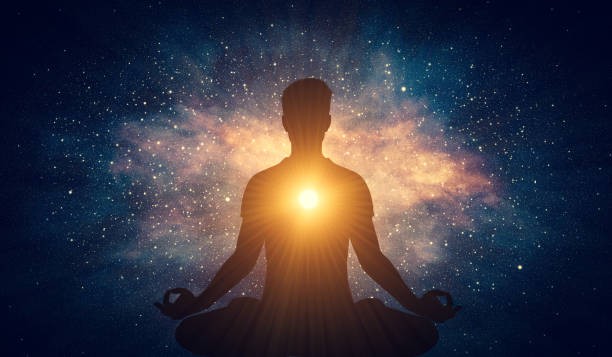
by Tirtha Acharya | Aug 15, 2024 | Yoga
Unlock Inner Strength with Meditation for Self-Empowerment
In today’s busy world, stress is a constant factor. It is your constant companion from the moment you get out of bed to the moment you get back to it. Amidst the noise and struggle of modern living, there exists a timeless exercise that offers a road to inner peace: Meditation. In this blog, we shall understand what meditation is and its use in self-empowerment.
The essence of meditation
Meditation is more than sitting in a place and emptying your mind. Rather, it’s a sacred journey that takes you deep into your own being. This ancient practice dates back thousands of years and despite its age, it’s pretty common. Based on the meditation you choose, you can meditate to relax, reduce stress, and cope with anxiety.
Meditation in different religions
Meditation has its roots in various religions. If you observe the pictures of Gods and Goddesses in such religions, you can see them in meditative posture.
- Hinduism: Meditation is an important element of Hinduism and it’s referred to as “Dhyana”. It’s primarily used to strengthen one’s connection with the divine being.
- Taoism: In Taoism, you can find practices like qigong and tai chi which emphasize maintaining inner harmony. Taoist meditation focuses on balancing oneself with the flow of Tao (the natural order of the universe).
- Sikhism: Meditation goes by the name of ‘simran’ and means remembering the divine. The general practice involves reciting the name of God as a means to achieve inner peace.
- Buddhism: Meditation plays a crucial role in Buddhism where it’s a fundamental aspect for spiritual development. Common meditation techniques for self-empowerment include vipassana and samatha.
What does meditation actually do?
The people who meditate are likely to experience the following benefits:
- Decrease in stress levels
- Lower blood pressure
- Enhanced immune function
- Better emotional well-being
- Effective pain management
- Improved focus and concentration
- Better sleep quality
Tips for starting your meditation journey
- Begin with baby steps
Starting a meditation journey should not be overwhelming. Beginners make the mistake of starting from longer sessions from the first day. Instead, start with just a few minutes of meditation each day and gradually increase the duration. You can increase the duration based on your comfort level. Remember, it’s the consistency of practice that brings results.
- Create a sacred space
Allocate a quiet and peaceful space for your meditation practice. Make sure that it’s a place away from your sleeping room. It should be a retreat where you can cancel out the noise and busyness of daily life. Whether it’s a quiet corner of your home or a peaceful spot in nature, choose a space that suits you the best.
- Explore different techniques
There are different techniques of meditation that you can use according to your needs. It’s also not necessary that you stick to just one method. Experiment with different styles of meditation—from mindfulness and loving-kindness to visualization and mantra meditation—and discover what clicks with you. Keep in mind that there are different approaches to meditation and you can select as per your need. So, trust your intuition and follow the path that calls to you.
- Have patience and persistence
Like any other skill, meditation requires patience, persistence, and dedication. It’s not something that you do once. Be gentle with yourself as you navigate the ups and downs of your meditation practice. You’ll experience days where nothing makes sense and even see days where you feel the best. Have faith in the process and find yourself closer to your true self.
- Accept the Journey
Approach your meditation journey for self-empowerment as a curious journey rather than an activity that you do out of compulsion. Accept each moment as an opportunity for growth and self-discovery, and find yourself glowing with the benefits of meditation.
In a world where we can sometimes feel lost and disoriented, meditation is a light that guides us. Taking the journey of meditation is a journey of self-empowerment, discovery, and growth. Through meditation, you’re not just sitting still; you’re actively reclaiming your sense and finding your purpose.
If you’re also looking to walk on the path of self-discovery then look no further than (insert company’s name). With years of expertise in the field of yoga and meditation, we’re your joyful companion in this wonderful journey.
For more blogs visit on our Nepal Yoga Home blog section.

by Tirtha Acharya | Aug 9, 2024 | Yoga
Celestial savasana is a yoga journey that takes in elements of the cosmos like the stars, moon, and universe. Although it may sound like something new or extraordinary, this practice of deep relaxation is quite ancient. Join me as we dive deep into the wonderful world of yoga practices with celestial savasana at the helm.
What is Celestial Savasana?
In simple words, celestial savasana is a yoga practice. It’s a derivation of the traditional yoga pose called the corpse pose. In this pose, you lie flat on the back in a relaxed state and allow the body to fully surrender to the ground. In this method of deep relaxation, you visualize yourself surrounded by celestial bodies.
Through this visualization, you connect yourself with the magic of the universe. If you are successful in maintaining a link, then you can feel the tranquil energy of the universe. The main objective of this practice is to maintain harmony with the cosmos while emphasizing mental peace mood and spiritual connection.
Preparing for Celestial Savasana:
To witness deep relaxation through celestial savasana, follow the below steps:
- Choose a peaceful place where you can lie down without any disturbance. This could be the corner of your home or a quiet room.
- Dim the lights or practice it in darkness. To make the environment soothing, you can light candles or use incense sticks.
- Set the mood by incorporating aromatherapy diffusers or essential oils. Make sure that the scent is not too overwhelming.
- Wear comfortable clothing which helps in unrestricted movement. Refrain from wearing tight clothing.
- If needed, gather props like blankets and cushions to support your body. These props help to release stress on the spine and joints.
- Before practicing celestial savasana and while doing it too, reflect on what you want to achieve during this practice.
- Make sure that you approach this practice with an open mindset. Let go of any expectations or judgments regarding it and fully surrender yourself to its wisdom.
Guided Celestial Savasana:
Now, let us take a guided Celestial Savasana journey together.
- Close your eyes and take a deep cleansing breath.
- Allow cosmic energy to flow freely through your body.
- With each inhalation, draw in the energy of the stars and feel the power infusing in your body.
- As you exhale, release any tension or worries.
Visualize yourself floating weightlessly in the universe and experience its energy. Synchronize your breathing with the pulse of the cosmos and drift into deep relaxation.
Benefits of Celestial Savasana:
The benefits of Celestial Savasana are as vast and boundless. It goes beyond deep relaxation and offers transformative benefits that transform the mind, body, and spirit. Here are just a few ways in which celestial savasana can enrich your life:
- Deep relaxation: Find yourself in a state of deep relaxation as you release tension and stress.
- Increased awareness: Build a sense of mindfulness and presence as you connect with the celestial energies that surround you. It helps to build clarity and inner peace.
- Emotional Balance: Find serenity amidst life’s challenges which nurtures emotional resilience and well-being.
- Spiritual Connection: Experience a profound sense of connection with the divine and the universe. It expands your consciousness and deepens your understanding of the universe.
As we reach the ending point of the celestial savasana journey, understand that it’s just one of the methods of finding inner peace. There are other different methods too which you can use to walk on the road to self-discovery and self-realization. Whether you’re looking at the sky or practicing meditation, know that you’re in the loving embrace of the universe. Take the magic of celestial savasana with you and walk on the road of deep relaxation.
For more blogs visit on our Nepal Yoga Home blog section.

by Tirtha Acharya | Jul 16, 2024 | Yoga
Mastering Yoga Sequencing for Balanced Health
What makes this universe so magnificent and awe-inspiring is its beautiful sequence. Everything around us embodies a unique, harmonious, and graceful balance.
An excellent achievement is the result of a remarkable sequence. One of the greatest blessings is the ability to lead a healthy life. A healthy life is the result of healthy choices – yoga is one of the best choices you can make.
Do you comprehend the difference between an incoherent and well-structured yoga practice? A sequence in yoga creates a beautiful rhythm. You can feel the significant impact it has on your life. The time that you spend learning the sequence will be your best investment.
After reading this article, you’ll understand the importance of balance and sequence in yoga. This article will help you establish yoga sequencing – making it easy to craft a flow for balance.
What is Yoga Sequencing?
Yoga sequencing is also known as vinyasa – it is made of two words, vin means “in a special way” and nyasa means “to place”. The term vinyasa came from a Sanskrit word which means a connection between asanas and breathing movements.
The sequence is designed to craft a smooth transition between different yoga positions to gain balance and internal peace.
Importance of Yoga Sequencing
Yoga welcomes everyone from a beginner to a pro. The importance of sequencing in yoga is inevitable. It cultivates a sense of fluidity, balance, deep relaxation, and spiritual connection.
Aesthetically pleasing videos on Instagram have one thing in common – which is a sequence. The sequence in videos makes you stay longer as it has a soothing effect on your eyes. Imagine the benefits of practical demonstration of sequence in yoga.
Sequencing in yoga is a creative touch that nourishes your body and soul. It sets a melodious tone that helps you fully embark on your yoga journey. It builds a foundation of discipline that is reflected in every chore of life.
Steps to Establish Yoga Sequencing
Here are 8 steps that can help to develop the sequence and balance in yoga.
1. Make a Proper Plan
Imagine cooking in a kitchen and not having ingredients and cut vegetables in front of you. It might take you double the amount of time and the reason is not planning. Perfect execution demands proper planning.
Good planning should be your starting point. If you’re thinking about time division, poses and sequence on the yoga mat, then you missed the train. Organize your thoughts and pre-plan everything before sitting on a yoga mat.
2. Set Clear Intentions
Right intention gives you focus in life. Try to figure out what you want from your efforts and work towards your goal. Intentions play a huge role in structuring someone’s progress.
When life is full of hustle, make yoga a relaxing and healing time. Make a pure intention and ask yourself the following questions.
- Why are you doing yoga?
- What benefit does it give you?
- How can you improve every day?
- What’s your objective at the end?
Make an intention to give the best effort and motivate yourself to step in with a positive attitude.
3. Opening of the Yoga
A quality opening sets a pace for yoga sequencing. A good start means half the work done. Give greetings to everyone and ensure a peaceful environment. Start with meditation to get awareness of body and mind.
Sukhasana is an opening part which means sitting in a comfortable position. Straighten your sitting posture and relax your body. Incorporate slow and deep breaths in the yoga opening. Detach yourself from worldly thoughts and focus on the moment.
4. Warm-Up Exercises
Warm-up means light and gentle activity that prepares you for the actual exercise. It prepares you to accept the challenge efficiently.
Warm-up exercise gets your blood flowing – providing more oxygenated blood to the brain. It removes muscle tension and improves movement. It raises body temperature which prevents injury.
Some examples of warm-up exercises for yoga sequencing are mentioned below:
- Cat-cow stretch
- Easy-twist
- Leg stretch
- Child’s pose
5. Standing Pose
The next in the line is the standing pose. This pose focuses on bringing strength and balance, especially to the lower body. You must stand in a proper upright position, with straight shoulders and firm feet on the ground.
Some examples of standing poses are below
- Tree Pose
- Triangle Pose
- Mountain Pose
- Reverse Warrior
- Malasada
6. Go For Peak Poses
The next step in yoga sequencing is peak poses. The reason behind warm-up is peak poses. These poses are the most challenging part of yoga.
Peak poses are the core element of yoga – it develops strength, flexibility, muscle endurance, balance, and flow.
Following are the examples of peak poses.
- Volcano Pose (Urdhva Hastasana)
- Cobra Pose (Bhujangasana)
- Dancer Pose (Natarajasana)
- Intense Side Stretch Pose (Parsvottanasana)
- Chair Pose (Utkatasana)
7. Smooth Transition Between Poses
Smooth transitions are a must for flow and balance in yoga. The way you make the transitions defines your yoga abilities.
At the point of transition, slow down your movement. Take care of the center of gravity to maintain the balance. Give yourself time to stabilize. Take a slow breath and absorb the energy. Transfer body weight carefully and strategically.
8. Savasana
Savasana is also known as the corpse pose. It’s the ending pose of yoga. The last 5-10 minutes are given to Savasana. This step is to end the yoga on a lighter note.
The end of yoga sequencing is calming in which the body is kept still. In savannas, a person lies down on the back. It ensures that you leave the yoga room with positive energy. It’s the most relaxing part of the yoga.
Conclusion
Yoga sequencing is an art that comes with consistent practice. Sequencing brings a huge difference in maintaining the flow and balance. It’s designed to bring contemplation through a combination of physical postures and breathing movements.
Without sequence, you can’t reach the desired goal. You can add sequences in yoga style, whether you’re a beginner or an advanced yogi. In the beginning, you can take the help of a professional in perfecting the sequence.
With time, you’ll perfect this skill. It just requires a little time, dedication, patience, and practice. I am hopeful that you’ll take a step to learn and master the art of sequencing in yoga.
For more blogs visit on our Nepal Yoga Home blog section.

by Tirtha Acharya | Jul 7, 2024 | Yoga
Life in the 21st century is quite busy. It’s filled with lots of things to do but very little time. While navigating through this never ending journey, it’s common to find yourself stressed. In such cases, it becomes important to find a moment for relief. There’s a practice that offers peace in this busy world: cyclic meditation. Join me as we explore the wonderful effects of cyclic meditation and how you can use it in your life.
Understanding Cyclic Meditation
Unlike conventional meditation techniques, cyclic meditation is quite different. It goes a step above that by incorporating rhythmic movements and a much focused awareness. In this practice, you will find controlled breathing and a greater connection with the soul. Cyclic meditation finds its origin in Eastern traditions and is used for its ability to reduce stress and improve focus.
The techniques in cyclic meditation aim to quiet the mind, release tension from the body, and develop mental clarity. You should practice it with a trained professional to learn more about it.
Benefits of Cyclic Meditation
Cyclic meditation offers both physical and mental benefits. At its heart, cyclic meditation is about finding stillness amid movement. Here are some of the key benefits:
- Stress Reduction: The rhythmic movements and different breathing patterns of cyclic meditation help release physical tension and mental stress. It allows practitioners to experience relaxation and inner calm.
- Enhanced Mental Clarity: By quieting the mind and focusing on the present, cyclic meditation enables practitioners to cultivate mental clarity and improve focus.
- Improved Physical Well-being: The gentle movements of cyclic meditation promote flexibility, strength, and balance and also help to maintain physical well-being.
- Emotional Balance: Through the practice of cyclic meditation, individuals can develop greater emotional resilience.
- Spiritual Growth: It provides an opportunity to connect with the deeper dimensions of the self and connect with nature.
Techniques and Practices
To practice cyclic meditation, follow these simple techniques:
- Find a quiet and comfortable space where nothing can disturb you.
- Begin with gentle stretching to loosen up the body and prepare it for movement.
- Stand tall with your feet hip-width apart and arms relaxed by your sides. Be gentle with your steps.
- Close your eyes and take a few deep breaths. Allow your body and mind to relax.
- Begin to move your body slowly and rhythmically. Synchronize your movements with your breath and proceed accordingly.
- Allow your movements to flow naturally and focus your attention on the sensations in your body.
- Continue for 10-15 minutes and gradually increase the intensity and speed of your movements.
- When you’re ready, slowly come to a stop.
Safety Considerations
While cyclic meditation is generally safe for most people, it’s important to listen to your body and practice with caution. Be sure to contact your healthcare professional if you have any underlying health issues. Remember to start slow and gradually increase the intensity of your practice as you feel more comfortable.
In conclusion, cyclic meditation offers a holistic approach to wellness that combines movement, breath, and promotes relaxation. It’s also helpful in maintaining mental clarity and promoting overall well-being. Whether you’re seeking stress relief, physical fitness, or spiritual growth, cyclic meditation has something to offer for everyone. So why not take the first step today and experience the magical power of cyclic meditation for yourself? Your mind, body, and spirit will thank you.
For more blogs visit on our Nepal Yoga Home blog section.

by Tirtha Acharya | Jul 2, 2024 | Yoga
It’s no secret that there are numerous physical and spiritual benefits of including yoga in your life. However, the spiritual aspects of yoga are not that well understood, various people have opposing views on whether yoga connects you to your spiritual self or not. In this article, we will be discussing the spiritual aspects of yoga.
Spiritual Aspect of Yoga:Promotes Inner Peace
One of the first spiritual aspects of yoga touches the depths of the human spirit and offers benefits beyond just strengthening and extending the body. Yoga helps reduce mental chatter through attentive breathing and meditation techniques, providing a unique kind of peace in today’s hectic environment. It teaches practitioners to be mindful of the here and now, developing a calmness that can be carried into everyday life as well as the yoga mat.
This inner peace is about building a deep reservoir of composure that can help weather life’s ups and downs, not merely about feeling at ease in the here and now. Yoga is an inspiring and spiritually liberating road to harmony and balance as practitioners learn to turn inward and connect with their true selves.
Yoga Reduces Stress
Reducing stress and providing a mental haven from the craziness of everyday life is one of the most profound spiritual aspects of yoga. The physical asanas, deliberate breathing, and relaxation or meditation that yoga practitioners employ together help to reduce the body’s stress reaction. A calmer state is encouraged by this all-encompassing approach rather than the fight-or-flight reaction that is typical in high-stress circumstances.
It has been observed that individuals who practice yoga have lower stress, and anxiety levels, lower heart rates, and decrease in blood pressure. Yoga allows you to focus in the moment and enhances your general well-being. In addition to that, the spiritual element of yoga helps people to get in touch with their bodies, minds, and emotions. This awareness helps them identify the reason behind their stress and eliminate it from the stem.
It Cultivates Self-awareness
The potential of yoga to enhance self-awareness is one of its great spiritual aspects. This age-old discipline unites breath, body, and mind to enhance practitioners’ awareness of themselves on a level beyond the physical poses seen in mainstream exercise. People can develop their inner connection, identify their thought patterns, and learn to listen to their bodies via regular yoga practice.
More emotional control, better decision-making, and a stronger sense of inner serenity and happiness can all result from this increased self-awareness. Yoga provides an avenue for self-exploration and personal development by promoting mindfulness and present-moment awareness. This allows practitioners to live more purposefully and peacefully, both on and off the yoga mat.
Offers Mental Focus and Clarity
The mind-clearing benefits of yoga are one of its many amazing features. Do you ever find it difficult to recall where you put your keys or how your brain feels at times when it’s cloudy? Of course, yoga can assist with that. Like when you’re practicing yoga, everything seems to just disappear as your attention is drawn to moving your body and breathing.
Your brain becomes trained to remain clear and sharp as a result. You’re not only stretching well, but you’re also exercising your thinking, which makes it fantastic. It’s similar to refreshing your browser, but for your mind instead. Imagine being able to concentrate and think enough to get through your day. Things simply get easier to deal with.
Open Your Third Eye with Yoga
The goal of yoga is to open up your third eye, which is one great feature. Though it’s not quite like that—if you were envisioning a miraculous eye appearing on your forehead it’s nonetheless fantastic in other ways. Our discussion of the third eye is mostly focused on insight and intuition. It’s similar to having superpowers that enable you to see and see extraterrestrial phenomena.
Yoga involves more than just stretching and holding positions; it also works on bringing your inner energy into balance. In many spiritual traditions, the third eye, which is located exactly between your eyebrows, is considered to be the source of intuition and insight. Yoga helps you get a glimpse of a deeper comprehension of the world around you and yourself by focusing on this region.
Imagine having a guide inside you, helping you make better choices and guiding you through tough times that’s your third eye getting into action. Opening it through yoga might not happen overnight, but with regular practice, you might start noticing you’re more in tune with your gut feelings and seeing things clearer. It’s like having an inner compass always pointing you in the right direction.
Yoga Calms Your Nerves and Mind
On one of those days when everything seems a little bit overwhelming, picture yourself. It seems as though you are turning off the world’s sounds as soon as you unfold your mat and begin your asanas. One breath at a time, decluttering your thoughts is just as important as stretching your body. You’re not just moving when you take each breath; you’re deliberately directing your thoughts toward a more peaceful state.
That calming feeling you get after yoga? Your mind appears calmer and more invigorated as if it had taken a spa day. For anyone trying to find some quiet amid the chaos, it’s practically a game-changer.
It Connects You to God
Yoga is a spiritual practice that can deepen your perception of God; it’s more than just a series of physical poses. Consider it as a link between the spiritual and mental domains that opens doors to a more profound experience of divinity and serenity within you.
You are exercising more than just your physical body when you roll over on your mat, practicing through the poses and paying attention to your breath. In addition, you’re clearing the clutter in your head to make room for something deeper. Many people feel a connection to a higher force, whatever that means to them, during these times of intention and silence.
Conclusion
In conclusion, the spiritual aspect of yoga is a powerful tool for connecting yourself with the divine and experiencing inner peace. By including yoga into your daily lives, you can reduce stress and cultivate self-awareness, leading to mental focus and clarity. The practice also offers us the opportunity to open our third eye and tap into our intuition, bringing a deeper understanding of ourselves and the world around us. Apart from these benefits there are various other spiritual aspects of yoga which you discover along the way.
For more blogs visit on our Nepal Yoga Home blog section.

by Tirtha Acharya | Jun 25, 2024 | Yoga
Anusara Yoga stands as a beacon of light in the realm of yoga, offering practitioners a transformative journey of self-discovery and alignment. Rooted in the principles of alignment, community, and heart-centered practice, Anusara Yoga goes beyond the physical postures, inviting individuals to align their mind, body, and heart in harmony. Founded on the belief that every individual possesses an innate goodness and the potential for transformation, Anusara Yoga at Shree Yoga represents a sacred space where practitioners can embark on a profound exploration of their inner selves.
In each Anusara Yoga class, practitioners are guided through mindful alignment techniques that not only strengthen the body but also foster a deeper connection with one’s intentions and aspirations. Led by experienced instructors who embody the essence of Anusara Yoga, classes provide a nurturing environment where students of all levels can cultivate self-awareness, resilience, and inner strength.
Anusara Yoga: Aligning Mind, Body, and Heart
At Shree Yoga, Anusara Yoga isn’t just about physical postures; it’s a journey of self-discovery, aligning the mind, body, and heart. Founded on the principles of alignment, community, and transformative experiences, Anusara Yoga offers a comprehensive approach to yoga that goes beyond fitness.
What to Expect from an Anusara Class:
In each Anusara Yoga class, practitioners can expect mindful alignment techniques that focus on harmonizing the body’s skeletal, muscle, and fascia structures. Led by experienced instructors deeply rooted in the philosophy of Anusara Yoga, classes offer a safe and supportive environment for practitioners of all levels to explore and deepen their practice.
Experienced Guidance:
With an emphasis on heart-centered practice, Anusara Yoga classes integrate meditation, reflection, and exploration of one’s intentions. The experienced guidance of instructors ensures that students not only improve their physical strength, flexibility, and balance but also cultivate a deeper awareness of themselves and their surroundings.
The History of Anusara Yoga:
Since its inception in 1997, Anusara Yoga has evolved into a global phenomenon, offering practitioners a path to personal growth and self-discovery. Despite challenges and transitions, the essence of Anusara Yoga remains rooted in its commitment to alignment, community, and transformative experiences.
The Anusara School of Hatha Yoga:
Under the umbrella of the Anusara School of Hatha Yoga, practitioners find a unified community dedicated to upholding the principles and values of Anusara Yoga. Through rigorous training, ongoing education, and community-building initiatives, the School ensures that the integrity and unique qualities of Anusara Yoga are preserved and celebrated. In essence, Anusara Yoga at Shree Yoga is more than just a physical practice; it’s a journey of self-discovery, alignment, and transformation, inviting practitioners to connect deeply with themselves and the world around them.
Conclusion
As we reflect on the journey of Anusara Yoga at Shree Yoga, we are reminded of its profound impact on the lives of practitioners worldwide. Beyond the physical postures and sequences, Anusara Yoga serves as a transformative path of self-discovery, alignment, and heart-centered practice. Through the guidance of experienced instructors and the support of a vibrant community, practitioners are empowered to deepen their practice, cultivate inner resilience, and align with their highest potential.
At Shree Yoga, Anusara Yoga represents more than just a series of exercises; it’s a journey of personal growth, connection, and transformation. As practitioners continue to explore the depths of their practice and align with their true essence, may they find peace, joy, and fulfillment on the sacred path of Anusara Yoga.
For more blogs visit on our Nepal Yoga Home blog section.






